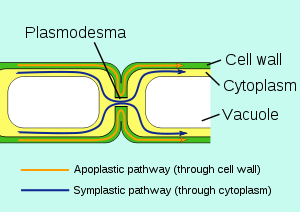Apoplast

Within a plant, the apoplast is the space outside the plasma membrane within which material can diffuse freely. It is interrupted by the Casparian strip in roots, by air spaces between plant cells and by the plant cuticle.
Structurally, the apoplast is formed by the continuum of cell walls of adjacent cells as well as the extracellular spaces, forming a tissue level compartment comparable to the symplast. The apoplastic route facilitates the transport of water and solutes across a tissue or organ.[1] This process is known as apoplastic transport.
The apoplast is important for all the plant's interaction with its environment. The main carbon source (carbon dioxide) needs to be solubilized in the apoplast before it diffuses through the plasma membrane into the cell's cytoplasm (symplast) and is used by the chloroplasts during photosynthesis. In the roots, ions diffuse into the apoplast of the epidermis before diffusing into the symplast, or in some cases being taken up by specific ion channels, and being pulled by the plant's transpiration stream, which also occurs completely within the boundaries of the apoplast. Similarly, all gaseous molecules emitted and received by plants such as plant hormones and other pheromones must pass the apoplast. In nitrate poor soils, acidification of the apoplast increases cell wall extensibility and root growth rate. This is believed to be caused by a decrease in nitrate uptake (due to deficit in the soil medium) and supplanted with an increase in chloride uptake. H+ATPase increases the efflux of H+, thus acidifying the apoplast.[2] The apoplast is also a site for cell-to-cell communication. During local oxidative stress, hydrogen peroxide and superoxide anions can diffuse through the apoplast and transport a warning signal to neighbouring cells. In addition, a local alkalinization of the apoplast due to such a stress can travel within minutes to the rest of the plant body via the xylem and trigger systemic acquired resistance.[3] The apoplast also plays an important role in resistance to aluminum toxicity and resistance. Exclusion of aluminum ions in the apoplast prevent toxic levels which inhibit shoot growth, reducing crop yields[4]
History
The term apoplast was coined in 1930 by Münch in order to separate the "living" symplast from the "dead" apoplast.[5][6]
Apoplastic transport
The apoplastic pathway is one of the two main pathways for water transport in plants, the other being symplastic pathway. In apoplastic transport, water and minerals flow in an upward direction via the apoplast to the xylem in the root.[7] The concentration of solutes transported in aboveground organs is established through a combination of import from the xylem, absorption by cells, and export by the phloem.[8] Transport velocity is higher in the apoplast than the symplast.[9] This method of transport also accounts for a higher proportion of water transport in plant tissues than does symplastic transport.[10] The apoplastic pathway is also involved in passive exclusion. Some of the ions that enter through the roots do not make it to the xylem. The ions are excluded by the plasma membranes of the endodermal cells.[11]
Notes
- Apoplast was previously defined as "everything but the symplast, consisting of cell walls and spaces between cells in which water and solutes can move freely". However, since solutes can neither freely move through the air spaces between plant cells nor through the cuticle, this definition has been changed. When referring to "everything outside the plasma membrane", the term "extracellular space" is in use.
- The word apoplasm is also in use with similar meaning as apoplast, although less common.
References
- ↑ Campbell, N.A.; Reece, J.B. (2002). Biology. California: Benjamin Cummings. pp. 753–754. ISBN 0-8053-6624-5.
- ↑ Skobelev, O (July 2010). "Accelerated root growth induced by nitrate deficit is related to apoplast acidification". Russian Journal of Plant Physiology. 57 (4): 489. ISSN 1021-4437.
- ↑ H. H. Felle; A. Herrmann; R. Hückelhoven; K.-H. Kogel (December 2005). "Root-to-shoot signalling: apoplastic alkalinization, a general stress response and defence factor in barley (Hordeum vulgare)". Protoplasma. Springer Wien. 227 (1): 17–24. doi:10.1007/s00709-005-0131-5. PMID 16389490.
- ↑ Horst, Walter. "The role of the apoplast in aluminium toxicity and resistance of higher plants: A review".Journal of plant nutrition and soil science. 1995. Vol.158(5), p. 419–428
- ↑ Münch, E (1930). Die Stoffbewegungen in der Pflanze. Verlag von Gustav Fischer, Jena.
- ↑ Sattelmacher, B. (2000). The apoplast and its significance for plant mineral nutrition. New Phytologist 149: 167–192, .
- ↑ Ross, Merrill A.; Lembi, Carole A. (2008). Applied Weed Science: Including the Ecology and Management of Invasive Plants. Prentice Hall. p. 79. ISBN 978-0-13-502814-8.
- ↑ Grignon, C.; Sentenac, H. (1991-01-01). "pH and Ionic Conditions in the Apoplast". Annual Review of Plant Physiology and Plant Molecular Biology. 42 (1): 103–128. doi:10.1146/annurev.pp.42.060191.000535.
- ↑ "Transport in Plants". Department of Biological Sciences, University of Illinois at Chicago. Retrieved 10 December 2015.
- ↑ Thomas N. Buckley, Grace P. John, Christine Scoffoni and Lawren Sack (17 June 2015). "How Does Leaf Anatomy Influence Water Transport outside the Xylem?". Plant Physiology. 168.
- ↑ Freeman, Scott (2011). Biological Science. San Francisco, California: Pearson Benjamin Cummings. p. 747. ISBN 978-0-321-59820-2.
Footnotes
- Salibury F; Ross C (1991). Plant Physiology. Brooks Cole. p. 682. ISBN 0-534-15162-0..
See also
| Look up apoplast in Wiktionary, the free dictionary. |